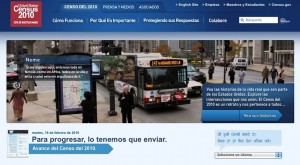Posted by Elena del Valle on March 31, 2010
Marketing Doesn’t Get More Direct than This
By Ricardo Quayat
Executive Creative Director, Rauxa Roja

Ricardo Quayat, executive creative director, Rauxa Roja
Photos: Rauxa Roja
Hispanic culture has always centered on “conversation and community” – that sense of belonging to something bigger than oneself. Combine this with the fact that more than 23 million Hispanics are online (more than half the Hispanic population)1, and it’s easy to see why social networking, as an extension of this community-centric way of thinking, is experiencing its largest audience boon within this segment. Ethnic minorities in fact visit social networking sites more frequently than non-Hispanic Whites 2, with Hispanics leading the way. Younger than the general population, and on the move in socioeconomic terms, this emerging market has the potential to redefine mainstream products and services through a viable and rapidly growing connection to social media.
Click here to read the complete article Reshaping Hispanic Marketing through Social Media
Posted by Elena del Valle on March 24, 2010

Food product labels include a list of ingredients
Photo: HispanicMPR.com
Can you tell which of the following four sweeteners, fructose, dextrose, sucralose and acesulfame potassium, is natural and which is artificial? If you know that the first two are natural sugars and the other two are artificial sugars you may be among 4 percent of surveyed respondents who knew the answer. The other 96 percent were not be able to identify the difference. Knowing what ingredients are contained in a product only helps, some advocates of enhanced food products labeling argue, if consumers know what the ingredients are.
If, like in this artificial versus natural sweeteners example, they don’t know a natural sweeter from any other ingredient listing the ingredients may offer few insights when consumers are making purchasing decisions based on nutritional content. Experts point out that often consumers have heard of the brand names like Equal but do not know the generic name like aspartame.
The confusion may be aggravated by the significant increase in sweeteners since labeling regulations began. Where there used to be five sweeteners there are now 27, according to a recent The Palm Post article. In 2005, the Sugar Association filed a petition with the Food and Drug Administration (FDA) requesting a labeling change to make it clear to buyers when there are artificial sweeteners in a product. A study, conducted by Harris Interactive and commissioned by the Sugar Association, indicates most parents of children 18 and younger prefer to avoid artificial sweeteners for their children.
With the high incidence of diabetes, obesity and chronic diseases related to dieting some believe truth and clarity in labeling are more important than ever. Among Latinos many of whom are at high risk of diabetes (see Exercise specialist, researcher explore diabetes issues relevant to Latinos) the issue may be aggravated by cultural practices and preferences and labeling, especially of chemical sounding and unfamiliar ingredients, may do little to help. That is not even taking into account Spanish dominant Latinos who have difficulty reading labels in English.
Executives at the Center for Science in the Public Interest are so convinced of the public confusion about labels that in December 2009 they sent a 150-page report, Food Labeling Chaos: the Case for Reform, to the FDA about false and misleading food labels. The report emphasizes three problem areas: the Nutrition Facts Panel, ingredient labels and false and misleading health-related claims.
They highlight a cereal (Kashi, owned by Kellogg) that promises “healthy arteries” from green tea ingredients although there is no FDA approval of such a relationship (between green tea and healthy arteries); an English muffin brand (Thomas’ Hearty Grains English Muffins) that touts whole grain although the main ingredient is “unbleached enriched wheat flower;” and fruit juices (Gerber Graduates Juice Treats) with pictures of fruits on the labels that are not contained in the juices.
The Center for Science in the Public Interest dual missions are to “conduct innovative research and advocacy programs in health and nutrition, and to provide consumers with current, useful information about their health and well-being.”
Posted by Elena del Valle on March 10, 2010

In the last few years, Americans (and others abroad) have witnessed the slow and painful breakdown of traditional print and broadcast media as the financial model that held up the media outlets became obsolete and a new one was not embraced well, quickly, efficiently, replaced with a better one or all of the above. While we wait for the dust to settle we rely on the media outlets and the journalists that remain to fill the large shoes of the many that are gutted or gone. That is a tall order. Now that they are teetering on the edge of disappearing, at least in some ways, many people have begun to realize how much they had come to rely on that news reporting in their daily lives.
Newspaper ad revenue took a nose dive a long time ago and doesn’t seem to be coming up for air any anytime soon. The industry had a 23 percent drop in ad revenue in the last two years, according to the State of the News Media 2009, a report about media in the United States. The researchers who prepared the report concluded that 20 percent or one of every five journalists working for newspapers in 2001 was no longer around by the end of 2008. They anticipated that journalist losses would be the worst in 2009. Other sources indicate this was the case.
In the newspaper segment alone more than 40,000 newspaper jobs were lost in 2009 and 21,000 were lost in 2008, according to the federal Bureau of Labor Statistics quoted in a December 2009 article by Joe Strupp of Editorandpublisher.com. That loss was more than any single year in the past 10 years. The experience and contacts of dozens upon dozens of senior journalists may be disappearing before our very eyes. As of the end of 2009 many senior newspaper editors were no longer at their jobs, and in most cases no longer in the newspaper industry. Last year lone some of the losses included senior men and women from well known national and local publications such as USA Today, Newsday, The Star-Ledger, The Oregonian, The San Diego Union-Tribune, Chicago Sun-Times and The Washington Times.
As media became fragmented and media executives searched for ad revenue to survive many lost touch with their audience. Local television stations shed news staff, saw falling, or for the lucky ones, flat ratings; and lost more revenue, 7 percent in an election year, according to the 2009 media report. Network news ad revenue fell and ratings dropped as well. Ethnic media too, which had shown signs of growth in the past, is now floundering. In 2008, the only shining light was cable news and many of those ratings increases dropped after the elections.
Meanwhile, in spite of the traditional media’s past disdain for online venues the audience has embraced new media and online media sources with a vengeance. In 2008, traffic to the top 50 news sites increased 27 percent and the number of people seeking news online went up 19 percent in two years. That could be the solution, some thought, except that the ad revenue did not follow the audience. Although two years ago ad revenue online grew about 30 percent per year two years in a row the ad revenue on online news sites stopped growing and continued declining in print.
Although nobody seems to know for sure some estimates place the revenue decline in the news industry at double previous numbers in 2008, the most recent year for which data seems available. There are those who believe the loss in revenue was even worse in network television. Last year was expected to be by far the worst all around.
The State of the News Media 2009 was the sixth edition of the Pew Project for Excellence in Journalism annual report on the state of the news media in the United States. Among the more than three dozen readers and several researchers the 2008 analysis covered 69,942 stories in an effort to find out what news media covered that year. The total was divided into 7,350 newspaper stories, 6,539 online stories, 19,796 network television stories, 21,892 cable news stories, and 14,365 radio stories.
Posted by Elena del Valle on March 1, 2010

Click on image to enlarge
Photo: Census Bureau
Hoping to count every man, woman and child, including many whose first language is not English, in the country in its decennial tally the Census Bureau will mail out 120 million forms starting in March. The 2010 Census questionnaire will be available in six languages: English, Spanish, Russian, Chinese, Korean and Vietnamese. For the first time, the government entity will mail out 13 million bilingual, English-Spanish forms as part of the census taking effort mandated by the U.S. Constitution.
In an effort to allay the fears and overcome the language barrier for Spanish speakers living in the United States, the Census Bureau recently announced 2010.census.gov/espanol/, a Spanish language section of the census website. According to a spokesperson at the Census Bureau, the organization’s website is in English and Spanish is the only other language. The Spanish language pages are designed to inform “the more than 34 million Spanish-speaking people about the 2010 Census and to demonstrate to the Hispanic community that participation is easy, important and safe,” according to a press release distributed last month.

Robert M. Groves, director, Census Bureau
“Every decade, the census has to adjust how it reaches out to a diverse and growing population. These new and interactive Web pages are just such an example of how the Census Bureau is continuing to respond to new challenges,” said Robert M. Groves, director, Census Bureau. “Our hope is that visitors can relate and understand the importance of their participation in the 2010 Census and how they personally can have an impact on the well-being of their communities. Our Spanish language 2010 Census Web site demonstrates the Census Bureau’s commitment to ensuring a fair and accurate count of the Hispanic population. The 2010 Census is easy, important and safe, and we urge everyone to make sure they are counted.”
In addition to the Spanish version of the 2010 website, the Census Bureau plans a one-page description and a user guide explaining how to answer the census questionnaire in 59 languages. While the 2000 Census paid advertising campaign was in 17 languages, the 2010 Census plans to include 28 languages in its advertising campaign.
Posted by Elena del Valle on February 24, 2010

Do race and ethnicity influence attitudes toward clothes? Probably. And, the concept of work clothes changes over time. Suits, for example, are required less frequently for women overall today than they were some years ago. While the suit has fallen out of popularity in general, it seems to have remained a staple in the wardrobe of black women. Black working women are three times more likely than average to have bought a suit in the last year, according to a recent Mintel survey. They are more likely to rely on shoes, boots, belts and jewelry to complete their outfit.
In spite of their conservative dress attitudes regarding suits black women respondents said they are much more likely to take fashion chances; and try out new designers and new brands before they become mainstream. Hispanic working women who responded to the survey said they consider designer labels important. At the same time, it appears from their responses to the survey questions that black, Asian and Hispanic working women are much more likely to visit a retailer in search of brand names.
For some women brand names provide an image boost; for the white women surveyed they represent a comfort zone. Researchers were left with the impression that once these consumers identify a brand they like they tend to return to it. As a result retailers that carry different brands all the time may have difficulty drawing these shoppers.
Hispanic, black, and Asian women said it is much more likely that they are no longer wearing the clothes they wore last year, suggesting that these women shop for work clothes much more often than non-Hispanic white women.
Perhaps because they are young as a group (the Latino population is generally younger than the overall population.) Hispanic women respondents are significantly less likely to say that they look for timeless or conservative looks.
Most survey takers, except white women, said they are much more likely to agree that fashion magazines help them decide which clothes to buy. Since they find high value in designer labels this makes sense. At the same time, white women who participated in the survey said are least likely to say that they are influenced by fashion magazines. This is curious since many or most fashion magazines primarily target a white women.
According to a company representative, fieldwork was conducted online in August 2009 among a sample of 503 working (outside the home) women parents 18 and older with access to the internet. Mintel is an international supplier of consumer, product and media intelligence.
Posted by Elena del Valle on February 17, 2010

Photos: Hulu, YouTube, Tremor Media
Americans’ thirst for online videos seems unquenchable (also see Americans are viewing online videos in record numbers). Last December, 178 million Americans watched 33.2 billion videos online, and Google was by far the main player in that space, according to information released earlier this month by the comScore Video Metrix service. ComScore is a Virginia based company specializing in digital media usage measurement. Most people connected to the Internet, 86.5 percent, watched videos with an average duration of four minutes.
Google sites visitors watched 13.2 billion videos and YouTube.com accounted for almost 99 percent of all videos viewed there. For the first time Hulu (NBC Universal, News Corporation and The Walt Disney Company share in the ownership stake of the company and are content providers) surpassed one billion monthly video streams or 3 percent of the market. Other significant players in the online video space included Microsoft sites, in third place, with 561 million or 1.7 percent; Fox Interactive Media with 551 million also 1.7 percent and Yahoo! sites with 539 million or 1.6 percent.
Each viewer watched an average of 187 videos in December. Some 136 million unique viewers visited Google sites watching 97.5 videos each during the month; 59.8 million Yahoo! sites fans viewed 9 videos each; and 56.8 million visitors on Fox Interactive Media watched 9.7 videos per viewer. Hulu viewers watched 22.9 videos each during the month, another record for the website.

Click on image to enlarge
What about ad reach? With a potential reach of 103.7 million viewers, 58.3 percent of the total audience, Tremor Media and BBE with a potential reach of 101.1 million viewers, 56.9 percent penetration, were the top video ad networks. The Advertising.com Video Network with 83.6 million viewers, 47 percent, was in third place.

Jason Glickman, chief executive officer, Tremor Media
“With our Acudeo technology tightly integrated within the player-environment across all of the sites in our in-stream network, Tremor Media is able to continually introduce new and innovative ad formats that can be reliably delivered at scale. These new formats benefit the entire video value chain – from advertisers to publishers to the end consumer – by putting the viewer in control, enhancing engagement, and making video advertising more effective for brands,” said Jason Glickman, chief executive officer, Tremor Media in a press release.
Things must be going well in the online video ad business. Tremor announced six new ad formats last month: Pre-Roll Plus Overlay, a clickable overlay that appears over the publisher’s content following a standard pre-roll; vChoice Select, allows the user to choose which video ad to watch before it’s delivered; vChoice Rotator, rotates multiple brand videos in a single unit, allowing advertisers with multiple video assets to offer fewer options as thumbnails within the vChoice menu, and rotate the options each time an impression is served to the same user; Data Feed, dynamically populates brand or location specific data within the ad unit automatically or via user input such as a zip code; Sequencer, offers a different creative for every sequential impression delivered; and In-Stream Live, a live video feed within the ad.
”Requests for Hispanic targeted campaigns tend to be geo-targeted to TX and CA,” said Shane Steele, vice president, Marketing, Tremor Media when asked about Hispanics and online video ads.
Very little information seemed to be available about online video ads targeting or viewed by Hispanics. No ethnic breakdown was included in the comScore data and none of the three ad leaders mentioned Latino ad campaigns specifically in their promotional materials online.
“Moving Beyond Traditional Media Measurement: measuring conversations and social media” audio recording

Presenter Katie Delahaye Paine, founder, KDPaine & Partners
Find out about
- Issues affecting online public relationships today
- Testing relationships as part of a survey
- Measuring ethnic group relationships
- Measuring foreign language communications in a similar ways to English
- Biggest challenges measuring conversations and social media
- Measuring online relationships with little or no money
Click here for information on “Moving Beyond Traditional Media Measurement”
Posted by Elena del Valle on February 16, 2010
Since 1973, National Ag Day is celebrated on the first day of Spring to provide recognition of the food and fiber industry’s contributions to America, the food many of us eat every day. The National Agri-Marketing Association (NAMA) and the American National CattleWomen (ANCW) planned the first National Agriculture Day nearly 30 years ago. Beginning in 1979, The Agriculture Council of America (ACA) has coordinated the National Agriculture Day celebration in Washington, D.C.
The idea is to unite the food and agricultural communities and educate the non-farm public about the industry which is mostly, 98 percent, family owned, according to the AdDay Blog. For a glimpse of the new animated Public Service Announcement see our Public Service Section on the right side of the page. Click on the ad to visit the AgDay.org website for event information. Nonprofit organizations are eligible for free public service announcement ad space on HispanicMPR.
Posted by Elena del Valle on February 8, 2010

Maria Azua, vice president, IBM Enterprise Initiatives
Photo: IBM
A podcast interview with Maria Azua, vice president of Cloud Computing Enablement, IBM Enterprise Initiatives, is available in the Podcast Section of Hispanic Marketing & Public Relations, HispanicMPR.com. During the podcast, Maria discusses Latino culture in social networks and cloud computing with Elena del Valle, host of the HispanicMPR.com podcast.
Maria has deep technical skills and extensive experience in software development, managing new innovation projects, start-ups, acquisitions, solution delivery and process excellence. She is responsible for the technical implementation, deployment and operations of the Common Cloud Platform Living Lab share service, as well as the IBM Smart Business Development and Test on the IBM Cloud. She is also responsible for the creation of a community of independent software vendors, business partners, and technical community that fosters cloud computing IT methodologies and applications.
Maria is also the author of The Social Factor Innovate, Ignite, and Win Through Mass Collaboration and Social Networking (2009 IBM Press, Pearson Education), a book about social networking based on Maria’s leadership in social networking tools at IBM (see IBM Executive discusses social media business benefits).
Prior to her current role, Maria was vice president of Technology and Innovation, reporting to the IBM chief information officer. In that role, she focused on the development of innovative IT solutions and the integration of new technologies. She created and managed the Technology Adoption Program (TAP) innovation program, where more than 120,000 IBM employees participate to create innovations in a development community. Her responsibilities in the CIO office also included the creation of the first IBM Green Data Center.
Maria was inducted into the Women In Technology International (WITI) Hall of Fame, and was named one of the “100 Most Influential Hispanics” by People magazine in 2006. She has 50 patents and 39 patents pending that span a wide spectrum of technologies. In 2006, the Society of Hispanic Professional Engineers (SHPE) recognized Maria with The Star Award for her contributions and dedication to the Hispanic community.
To listen to the interview, scroll down until you see “Podcast” on the right hand side, then select “HMPR Maria Azua,” click on the play button below or download the MP3 file to your iPod or MP3 player to listen on the go, in your car or at home. To download it, click on the arrow of the recording you wish to copy and save it to disk. The podcast will remain listed in the February 2010 section of the podcast archive.

Click here to buy The Social Factor
Posted by Elena del Valle on February 1, 2010

Many young women wear comfortable shoes to work and change into stylish shoes on arrival
Many moons ago, I won’t say how many, someone I held in high regard said to me that a lady could always be identified in two ways, by her hair style and the shoes on her feet. Yesterday’s lady is today’s working woman. Whatever the driver is many women who work today have a fondness or fascination for shoes. For career minded women shoes, 64 percent according to a recent Mintel survey, are the preferred accessory to complete an ensemble.
Respondents to the survey on women’s attitudes towards work attire indicated they favor shoes and dress boots over other types of accessories. After footwear jewelry was the second most popular embellishment while purses, belts and scarves were the least likely additions; 52 percent of working women said they finish their looks with necklaces, earrings and bracelets. Only one third of women said they rely on purses, belts and scarves.
As women age they are less likely to change from comfortable into stylish shoes once they are at work. About 44 percent of women surveyed aged between 35 and 44 said they change into more stylish footwear on arrival at work while only less than a third of women 35 and up said they do that.
“Shoes and boots have come into the fashion forefront as women look for ways to make their outfits stand out,” said Kay Fay, senior analyst at Mintel, in a press release. “Demanding shoe styles, especially those with sky high heels, aren’t ideal for walking long distances. But many young women don’t care; they’re perfectly content to cart in a second pair of shoes so they can commute in comfort yet look stylish in the office.”
Most women who participated in the survey, 82 percent, said they dress for themselves; and only 34 percent said they dress to be fashionable. Among respondents, young women were the most concerned with trends; 46 percent of young women, aged 18 to 34, like to follow trends. While only 33 percent of women overall said they like to try new styles, 47 percent of women aged 18 to 24 responded that they like new designs. No information on preferences by ethnic or racial group was available from the survey.
The survey was conducted online in August 2009 among a sample of 503 women parents aged 18 and older who had access to the internet and who worked outside the home. Mintel is an international supplier of consumer, product and media intelligence.
“Happy for No Reason” audio recording

Presenter Marci Shimoff, author, Happy for No Reason
What: An audio presentation by Marci Shimoff and Q&A with Marci Shimoff and HispanicMPR.com audio program host Elena del Valle about finding happiness.
Available exclusively on HispanicMPR.com!
Click here to listen to a short interview with Marci
Click here for more information on “Happy for No Reason” audio recording with Marci Shimoff
Posted by Elena del Valle on January 27, 2010

Angela M. Kelley, vice president, Center for American Progress
Photo: Center for American Progress
While everyone is talking about unemployment and the recession who is paying attention to the increasing costs of maintaining our borders safe? Miles and miles of fence and even a portion of wall mar the United States Mexico line. Taxpayers are footing the ever growing bill that has jumped from $326 million in 1992 to $2.7 billion last year (The Economist, January 20, 2010).
At the same time, recent data indicates the cost of catching illegal immigrants is on the rise. In 2008, the border patrol made more than 791,000 arrests. Each one cost a little more than $3,000. Some question the efficacy of these efforts since illegal immigration tripled in those 17 years. In part, they believe, it is because many immigrants arrive into the country legally with tourist visas and remain illegally.
Looking inward, the question remains of how to deal fairly with the 12 to 15 million undocumented immigrants that are now in the country. Deporting 12 million illegal immigrants would require a convoy of more than 200,000 buses over more than 1,800 miles and that mass deportation would cost nearly $300 billion over five years, according to Principles for Immigration Reform Guidelines for Fixing Our Broken Immigration System, a report of the Center for American Progress (CAP) written by Marshall Fitz and Angela Maria Kelley and published December 2009. The Center for American Progress is a Washington, D.C. based think tank dedicated to “improving the lives of Americans through ideas and action.”
Some believe legalizing the status of the millions of undocumented residents would boost the economy over the long term. Raúl Hinojosa-Ojeda, Ph.D., founding director of the North American Integration and Development Center at the University of California, Los Angeles conducted research that leads him to believe that legalization of unauthorized workers would yield $1.5 trillion to the U.S. gross domestic product in 10 years. In three years it may generate $4.5 to $5.4 billion in tax revenue and consumer spending to support 750,000 to 900,000 jobs. In these days of economic contraction, unemployment and outsourcing, shouldn’t the powers that be listen to credible people promoting ways to generate jobs and additional GDP while saving millions in deportation costs?
“These are stark and significant numbers that lawmakers should commit to memory,” said Kelley, vice president for Immigration Policy and Advocacy at the Center for American Progress. “We have got an issue where we know we can improve the economy. It would be to their peril for lawmakers to be short sighted and not pass comprehensive immigration reform legislation that will reverberate and rev up the economy and help all Americans.”
According to Dr. Hinojosa’s research, a comprehensive immigration reform plan that legalizes the status of unauthorized workers and establishes a flexible visa program could result in higher wages for all workers in the country; while deporting the workers could cost $2.5 trillion over 10 years. That would be in addition to the costs of deportation of at least 12 million people.
























